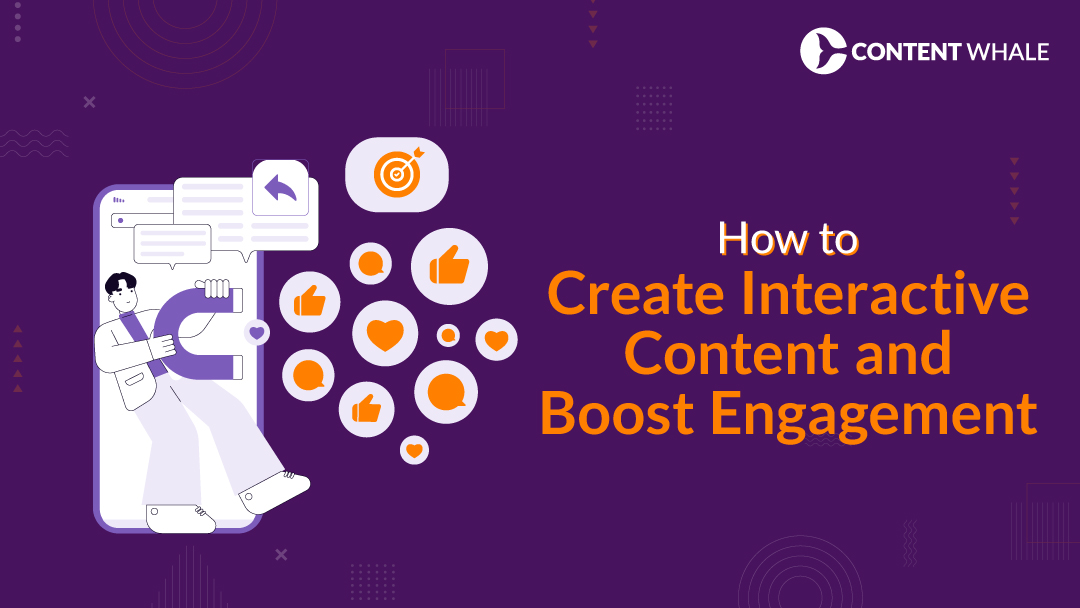Interactive content involves elements like quizzes, polls, and interactive infographics that require user participation. It’s crucial in content marketing to enhance audience engagement and improve user experience. The benefits of interactive content include better data collection, improved SEO, and higher conversion rates.
Learn how to create interactive content, including steps such as identifying your audience, choosing the right format, and using interactive content tools like Outgrow, Typeform, and Ceros. Implement best practices for design, mobile responsiveness, clear calls to action, and performance analysis to maximize the impact of your interactive content.
Interactive content involves elements that actively engage users, such as quizzes, polls, and interactive infographics. It’s becoming essential in digital marketing due to its ability to capture attention and enhance user experiences. Businesses that leverage interactive content creation can see significant improvements in user engagement and retention.
Interactive content has numerous benefits. It encourages users to spend more time on your site, reduces bounce rates, and provides valuable data insights. Additionally, interactive elements can make content more shareable, boosting social media visibility and SEO performance.
Incorporating interactive content tools into your strategy can streamline the creation process. These tools allow marketers to build engaging content without needing extensive technical skills. As part of a broader content marketing strategy, interactive content can significantly boost audience engagement and conversion rates.
Understanding Interactive Content
Interactive content involves engaging elements that require user participation. This distinguishes it from static content, which is passively consumed. Here, we explore the definitions, differences, and examples of interactive content.
1. Definition and Explanation
Interactive content is any digital content that requires users to engage actively. This can include actions like clicking, answering, or exploring elements within the content. Unlike static content, which users simply read or watch, interactive content prompts participation, making it more engaging and memorable.
2. Differences Between Static and Interactive Content
Static content, such as blog posts and articles, provides information without requiring user input. It’s informative but can often lead to shorter engagement times. Interactive content creation, however, involves elements that invite user interaction, resulting in longer engagement times and better user retention. For instance, an interactive quiz can hold a user’s attention much longer than a static article.
3. Examples of Interactive Content
- Quizzes and Assessments: These test users’ knowledge or provide personalized results based on user inputs.
- Polls and Surveys: These gather user opinions and feedback, providing valuable insights.
- Interactive Infographics and Videos: Infographics allow users to explore data interactively, while videos can include clickable elements that lead to different outcomes or additional information.
- Calculators and Tools: These provide users with instant results based on their inputs, such as mortgage calculators or fitness trackers.
Interactive content offers significant benefits. It boosts user engagement, improves data collection, and enhances user experience, making it a powerful tool in content marketing strategies.
Understanding how to create interactive content is essential for modern marketers. Using interactive content tools can simplify the process, enabling you to produce engaging content without technical skills. By incorporating interactive elements, businesses can increase audience engagement and achieve better marketing outcomes.
Benefits of Interactive Content

Interactive content offers numerous advantages for businesses and marketers. Here, we delve into the key benefits that make it a valuable addition to any content marketing strategy.
1. Increased Audience Engagement
Interactive content significantly boosts audience engagement. Users are more likely to spend time interacting with quizzes, polls, and infographics than simply reading a static article. This engagement helps to create a more memorable and impactful experience.
2. Enhanced User Experience
One of the primary benefits of interactive content is the improved user experience. Interactive elements make content more enjoyable and easier to digest. For example, an interactive infographic can help users understand complex data in a more engaging way than a static chart.
3. Improved Data Collection and Insights
Interactive content allows for better data collection. Quizzes, polls, and surveys can gather valuable insights about user preferences and behaviours. This data is essential for refining marketing strategies and enhancing interactive content creation.
4. Boosted SEO and Social Sharing
Interactive content can improve your SEO. Engaging content reduces bounce rates and increases the time users spend on your site. Additionally, interactive elements are more likely to be shared on social media, further boosting your online visibility.
5. Higher Conversion Rates
Interactive content can lead to higher conversion rates. Personalized experiences, such as quizzes that recommend products, guide users towards making informed purchasing decisions. This targeted approach can significantly enhance audience engagement and drive conversions.
The benefits of interactive content are clear. From increased engagement to improved SEO and conversion rates, interactive elements are a powerful tool in content marketing. Utilizing interactive content tools can streamline the creation process, making it easier to incorporate engaging elements into your content strategy. Understanding how to create interactive content effectively can help businesses achieve better marketing outcomes and enhance user experiences.
Types of Interactive Content

Various types of interactive content can help boost audience engagement and make your content marketing efforts more effective. Here are some popular formats:
1. Quizzes and Polls
Quizzes and polls are powerful interactive content tools. They can entertain, educate, and engage your audience, making them feel valued and heard. Quizzes like “What’s Your Marketing IQ?” draw users in and collect valuable data. Polls gather user opinions quickly and easily, providing insights into preferences and behaviours.
2. Interactive Videos
Interactive videos enhance the viewing experience by allowing users to interact with elements within the video. Whether you choose your own adventure or influence the video’s outcome, interactive videos provide a more engaging and immersive experience. These videos can include clickable links, branching scenarios, or interactive quizzes.
3. Interactive Infographics
Interactive infographics bring data to life with animations, clickable icons, and zoomable areas. They allow users to explore complex information in an engaging way. These infographics can make data more accessible and interesting, enhancing user understanding and retention.
4. Virtual Reality (VR) and Augmented Reality (AR)
VR and AR offer immersive experiences that engage users uniquely. VR can provide virtual tours or training modules, while AR allows users to “try” products before buying, such as furniture or makeup. These technologies enhance user experience and confidence in purchasing decisions.
5. Interactive Social Media Content
Social media platforms like Facebook, Twitter, and Instagram offer dynamic features for interactive content. Examples include 360-degree photos, polls, and interactive stories. These features encourage users to engage actively with your content, increasing visibility and interaction.
6. Chatbots
Chatbots provide real-time interaction, answering user queries and guiding them through processes. They can improve customer satisfaction, gather data, and enhance user engagement. Chatbots can simulate human interaction, making users feel more connected and supported.
7. E-Commerce Recommendations
E-commerce recommendation systems ask questions to filter products and offer personalized suggestions. They enhance the shopping experience by providing tailored product recommendations, increasing customer satisfaction and sales.
8. Giveaways
Giveaways engage users by offering rewards for participation. They can boost brand visibility and collect user data by encouraging participants to share content or sign up for newsletters. Giveaways create excitement and encourage user interaction.
Understanding how to create interactive content involves selecting the right format and using appropriate interactive content tools. These tools simplify the creation process, making it easier to produce engaging content. By incorporating interactive elements, businesses can enhance audience engagement and achieve better marketing outcomes.
Steps to Create Interactive Content

Creating interactive content involves several key steps to ensure it is engaging and effective. Here’s a guide on how to create interactive content successfully.
1. Identify Your Audience and Goals
Start by identifying your target audience and defining your goals. Understanding your audience’s preferences, interests, and pain points is crucial for creating relevant interactive content. Clear goals will guide the interactive content creation process, whether you aim to educate, entertain, or collect data.
2. Choose the Right Type
Selecting the appropriate type of interactive content depends on your objectives. Interactive infographics or assessments work well for educational purposes, while quizzes and polls are effective for entertainment. Use interactive content tools to explore different formats and find the best fit for your goals.
3. Plan and Design
Planning and designing the content layout is essential. Create a storyboard or wireframe to map out the user journey. Ensure the design is user-friendly and visually appealing. Use clear, concise text and engaging visuals to enhance audience engagement.
4. Develop Interactive Elements
Use interactive content tools like Outgrow, Typeform, or Ceros to develop interactive elements. These platforms offer drag-and-drop features and templates that simplify interactive content creation. Focus on creating elements that encourage user interaction, such as clickable buttons, quizzes, or interactive videos.
5. Test and Optimize
Testing is crucial to ensure your interactive content functions smoothly. Test on different devices and browsers to ensure compatibility and responsiveness. Gather feedback from a small group of users and make necessary adjustments. Optimize the content for performance, focusing on load times and user experience.
Understanding how to create interactive content involves a structured approach. By identifying your audience, choosing the right type, planning and designing effectively, developing interactive elements, and testing thoroughly, you can create engaging and impactful content. Using the right interactive content tools and following these steps will enhance audience engagement and improve your content marketing strategy.
Tools for Interactive Content Creation

Choosing the right tools is essential for creating effective interactive content. Here are some popular interactive content tools that can streamline the process and enhance audience engagement.
1. Outgrow
Outgrow is a versatile platform for creating interactive quizzes, calculators, polls, and chatbots. It offers a user-friendly drag-and-drop interface, making it easy to build engaging content without coding skills. Outgrow integrates with various marketing tools, helping to streamline your content marketing efforts.
2. Typeform
Typeform specializes in creating interactive forms, surveys, and quizzes. Its intuitive design and engaging interface make it an excellent choice for collecting user feedback and data. Typeform supports integrations with many apps, enhancing its functionality and making interactive content creation seamless.
3. Ceros
Ceros is a powerful tool for designing interactive infographics, eBooks, and other rich media content. It provides a no-code platform, enabling marketers to create visually stunning and engaging content. Ceros is ideal for brands looking to enhance their content marketing strategies with interactive elements.
4. ThingLink
ThingLink allows users to create interactive images and videos with clickable hotspots. This tool is perfect for adding layers of information to visual content, making it more engaging and informative. ThingLink is widely used in education and marketing to create immersive experiences.
5. Mapme
Mapme is an interactive map builder that helps create beautiful, engaging maps. It supports multimedia content, such as photos and videos, enhancing the storytelling experience. Mapme is great for businesses wanting to showcase locations, tours, or events interactively.
Resources for Interactive Content Creation
Stock Image
Several resources, in addition to tools, can aid in the interactive content creation process. These resources provide inspiration, templates, and best practices for creating effective interactive content.
1. HubSpot Academy
HubSpot Academy offers free courses on content marketing, including how to create interactive content. These courses cover the basics of interactive content and provide practical tips and templates to help you get started.
2. Canva
Canva provides a range of templates and design tools that can be used to create interactive infographics, presentations, and more. Its easy-to-use interface makes it accessible for beginners and experienced designers alike.
3. Visme
Visme is another excellent resource for creating interactive presentations and infographics. It offers a variety of templates and customization options, making it easy to design engaging content. Visme also provides tutorials and guides to help you make the most of its features.
4. Tips for Maximizing Efficiency
To maximize the efficiency of these tools and resources, follow these tips:
- Plan Your Content: Outline your content structure and objectives before starting.
- Use Templates: Leverage built-in templates to save time and to ensure the consistency.
- Test Thoroughly: Always test your interactive content on different devices and browsers.
- Integrate Tools: Connect your interactive content tools with your marketing platforms for seamless data flow and analysis.
Effective interactive content creation requires the right tools and resources. Platforms like Outgrow, Typeform, and Ceros simplify the process, allowing you to create engaging content that boosts audience engagement. By choosing the appropriate tools and following best practices, you can enhance your content marketing strategy and achieve better results.
Best Practices for Interactive Content

Follow these best practices to maximize the impact of interactive content. These guidelines will help you create engaging, effective content that resonates with your audience.
1. Create Visually Appealing and User-Friendly Designs
Ensure your interactive content is visually appealing and easy to navigate. Use high-quality images, clean layouts, and intuitive interfaces. A well-designed interactive experience will enhance audience engagement and make your content more memorable.
2. Ensure Mobile Responsiveness
Make sure your interactive content is optimized for mobile devices. With a significant portion of users accessing content on smartphones, mobile responsiveness is crucial. Test your content on various devices to ensure it looks and functions well everywhere.
3. Incorporate Clear Calls-to-Action
Include clear and compelling calls-to-action (CTAs) in your interactive content. Guide users on the next steps, whether it’s signing up for a newsletter, sharing the content, or making a purchase. Effective CTAs can significantly boost conversions and audience engagement.
4. Analyze Performance Metrics and Make Adjustments
Analyze the performance of your interactive content regularly. Use tools like Google Analytics to track engagement metrics, such as time spent on content, interaction rates, and conversion rates. Based on this data, make necessary adjustments to improve user experience and effectiveness.
5. Keep Content Updated and Relevant
Update your interactive content regularly to keep it fresh and relevant. Incorporate new information, update visuals, and refine interactive elements to maintain audience engagement. Regular updates ensure that your content remains valuable and interesting to users.
Implementing these best practices will enhance the effectiveness of your interactive content creation. By focusing on design, mobile responsiveness, clear CTAs, performance analysis, and regular updates, you can maximize the benefits of interactive content. Using the right interactive content tools and following these guidelines will strengthen your content marketing strategy and improve engagement with your audience. Understanding how to create interactive content effectively is key to achieving these results.
Conclusion

Interactive content is a vital component of modern content marketing strategies. It transforms passive users into active participants, enhancing audience engagement and delivering numerous benefits. Businesses can enjoy improved user experience, better data collection, and higher conversion rates by leveraging interactive content creation.
Understanding how to create interactive content involves selecting the right formats, using appropriate interactive content tools, and following best practices. These steps ensure that your content is not only engaging but also effective in achieving your marketing goals.
By incorporating interactive elements like quizzes, polls, videos, and infographics, you can make your content more dynamic and appealing. Regular updates and performance analysis further enhance the benefits of interactive content. Implementing these strategies will help you stay ahead in the competitive world of content marketing.
FAQs
What is interactive content, and why is it important?
Interactive content involves elements that require user participation, such as quizzes, polls, and interactive videos. It enhances user engagement and makes the content more memorable. This type of content is important because it improves user experience, boosts engagement, and can lead to better marketing outcomes.
How does interactive content differ from static content?
Static content, like articles, is passively consumed. Interactive content creation involves engaging elements that require active participation, such as clicking, answering questions, or exploring data. This makes the content more engaging and can significantly improve audience engagement.
What are some popular types of interactive content?
Popular types of interactive content include quizzes, polls, interactive infographics, videos, calculators, and augmented reality experiences. These formats actively involve users, making the content more engaging and effective.
Can interactive content improve my SEO?
Yes, interactive content can boost SEO. It increases user engagement, reduces bounce rates, and encourages social sharing. These factors contribute to better search engine rankings, enhancing the visibility of your content.
What tools can help me create interactive content?
Several interactive content tools can help create engaging content. Outgrow is excellent for quizzes and calculators. Typeform specializes in interactive forms and surveys. Ceros allows for the creation of interactive infographics and eBooks. These tools simplify interactive content creation and enhance your content marketing strategy.





